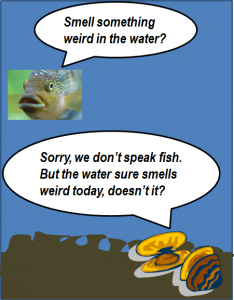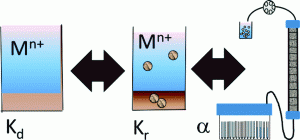 You and I are not friends, for you are a fish and I am a clam. We are uneasy neighbours. The river water is your playground, the sediment – my sanctuary. If we were living in the Elk River in West Virginia, both of us would have been worried on January 9, 2014. Something changed in the water that day, as crude 4-methylcyclohexanemethanol (MCHM) poured into the river from a leaky storage tank. Would the MCHM have dissolved in the water or bound to sediment? Which of us would have been in more danger – the resident of the water or the denizen of the sediment?
You and I are not friends, for you are a fish and I am a clam. We are uneasy neighbours. The river water is your playground, the sediment – my sanctuary. If we were living in the Elk River in West Virginia, both of us would have been worried on January 9, 2014. Something changed in the water that day, as crude 4-methylcyclohexanemethanol (MCHM) poured into the river from a leaky storage tank. Would the MCHM have dissolved in the water or bound to sediment? Which of us would have been in more danger – the resident of the water or the denizen of the sediment?
But you are no fish and I am no clam. So, we could try to answer these questions by doing some batch experiments: Take some sediment sample in a bottle, add some water and MCHM, close the bottle tight and shake it for some time. Then measure the concentrations of MCHM and to figure out whether it loves the water or prefers the sediment. We could also run column experiments: Mix some MCHM in water, flow through a packed column and measure the concentrations at the column inlet and outlet to see how much of the MCHM attaches to the column and how much is still left in water at the outlet.
The information gleaned from these experiments regarding the relative concentrations in the sediment, the water or the packed column, are called fate descriptors. Researchers have calculated fate descriptors for thousands of chemicals to figure out whether they partition into the water or the sediment, or volatilize into the air. Fate descriptors help us predict who faces the greatest danger – the clam, the fish or the dragonfly hovering over the water.
Can we run these batch and column experiments to reliably predict the behaviour of nanoparticles in the environment? The concept of fate descriptors calculated from batch and column experiments was established for molecular chemicals.
 But nanoparticles have distinctly different properties and do not behave as single molecules. The use of some previously established fate descriptors to predict the environmental fate and transport of nanoparticles has come under criticism.
But nanoparticles have distinctly different properties and do not behave as single molecules. The use of some previously established fate descriptors to predict the environmental fate and transport of nanoparticles has come under criticism.
In a recent perspective article, Dr. Geert Cornelis has discussed the challenges in developing environmentally relevant fate descriptors for nanoparticles. In the same vein, at the 3rd Sustainable Nanotechnology Organization Conference, Dr. Mark Wiesner and Dr. Greg Lowry stressed on the need to develop functional assays that provide nano-specific fate descriptors.
Like the batch and column experiments, these functional assays need to be operationally simple and of relatively short duration. Indeed, as mentioned in in the perspective article, “[t]he most appropriate method is most likely a compromise between technical accuracy and operational simplicity…”.
You can read more about these challenges and potential solutions in the full article for free*:
“Fate descriptors for engineered nanoparticles: the good, the bad, and the ugly”
Geert Cornelis
Environ. Sci.: Nano, 2015, Advance Article
DOI: 10.1039/C4EN00122B
—————-
About the webwriter
Paramjeet Pati is a PhD Candidate at the Virginia Tech Center for Sustainable Nanotechnology (@VTSuN).
You can find more articles by him in the VTSuN blog, where he writes using the name coffeemug.
—————-
*Access is free through a registered RSC account – click here to register










